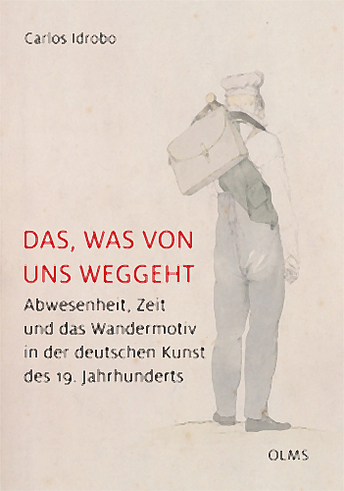Idrobo
Das, was von uns weggeht
ISBN 978-3-487-15693-4
englischSince antiquity, the depiction of farewell has been one of the major themes in the visual arts, as well as in music and literature. In particular, the departure of the wanderer at the beginning of his journey, often with an undetermined destination, has occupied countless important painters and draughtsmen and also challenged the viewer to philosophical reflection: How does that which departs from us appear? At the beginning of the wandering, the face of the wanderer is still recognisable, soon only his profile, soon his back. Slowly he moves into anonymity and his individual features disappear. What remains is the image of a figure on his back - seemingly motionless and yet on the move. And all we experience is an anticipation of the moment when the wanderer actually disappears or returns. On the basis of 7 depictions of the wanderer as a figure on his back in the works of Moritz von Schwind, Carl Gustav Carus, Carl Spitzweg, Caspar David Friedrich and Arnold Böcklin, Carlos Idrobo examines the aesthetic connection between wandering, absence and time in 19th century painting. In doing so, his study moves along the middle path between art history and philosophy, also confidently incorporating insights from dance, music and literary studies, thus enabling a contemporary view of canonical works of art history.
Die Darstellung des Abschieds zählt seit der Antike zu den großen Themen in der bildenden Kunst, ebenso wie in Musik und Literatur. Insbesondere der Aufbruch des Wanderers am Beginn seiner Reise mit oftmals unbestimmtem Ziel hat unzählige bedeutende Maler und Zeichner beschäftigt und auch den Betrachter zu philosophischen Überlegungen herausgefordert: Wie erscheint das, was von uns weggeht? Zu Beginn der Wanderschaft ist das Gesicht des Wanderers noch erkennbar, bald nur sein Profil, bald der Rücken. Langsam bewegt er sich in die Anonymität und seine individuellen Charakterzüge verschwinden. Zurück bleibt das Bild einer Rückenfigur – scheinbar bewegungslos und dennoch im Aufbruch. Und alles, was wir erfahren, ist eine Erwartung des Moments, in dem der Wanderer tatsächlich verschwindet oder wieder zurückkehrt. Anhand von 7 Darstellungen des Wanderers als Rückenfigur bei Moritz von Schwind, Carl Gustav Carus, Carl Spitzweg, Caspar David Friedrich und Arnold Böcklin untersucht Carlos Idrobo den ästhetischen Zusammenhang von Wandern, Abwesenheit und Zeit in der Malerei des 19. Jahrhunderts. Dabei bewegt sich seine Studie auf dem Mittelweg zwischen Kunstgeschichte und Philosophie, bezieht auch Erkenntnisse aus Tanz-, Musik- und Literaturwissenschaft souverän mit ein und ermöglicht so einen zeitgenössischen Blick auf kanonische Werke der Kunstgeschichte.


